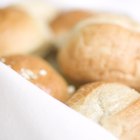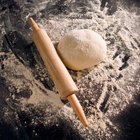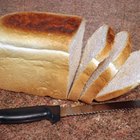
Some frozen breads, such as baking powder biscuits and pancakes, can be cooked without thawing them, but yeast doughs must be thawed so they can rise before baking. Giving frozen dough a bit of heat is the fastest way to thaw it, but be careful. Intense heat will bake the dough before it's thawed, resulting in a hard, heavy mess.
Fast Food
The quickest way to thaw frozen bread dough is in the microwave. Spray a microwave-safe plate with nonstick cooking spray and place the dough directly on the plate. Microwave on the defrost setting, uncovered for three to five minutes. The dough may still need some time to rise, depending on the type of dough you have. This method works best for small loaves and rolls. Larger frozen loaves may not thaw evenly or may develop dry spots on the surfaces.
Warm and Cozy
A gentler, more reliable method for thawing bread dough is in a warm oven or over a heating vent. Spray a bowl or baking pan with nonstick cooking spray and place the dough in the pan. Cover the dough with plastic wrap or a clean kitchen towel. Set the dough in an oven set on its lowest setting or over a heating vent. Other warm areas in your kitchen work, too, such as the back of the stovetop. Some ovens have a "bread proofing" setting, which automatically sets the oven temperature at 100 degrees Fahrenheit -- the ideal temperature for thawing or rising bread dough. Using this method, your frozen dough should be ready to bake within 30 minutes to two hours -- not quite as fast as the microwave, but you'll get better results.
Leisure Time
Allowing frozen bread to thaw at room temperature isn't lightning quick, but it's probably faster than you think. Place a frozen loaf or rolls in a baking pan prepared with nonstick cooking spray. Cover the pan with plastic wrap or a clean towel and set it on a counter top away from drafts. Rolls will thaw within an hour or two, while loaves take two or three hours.
Rise to the Top
Merely thawing frozen yeast bread isn't enough to produce light, delicious results. The bread must have time to rise and double in size. As the yeast in the bread warms, it produces carbon dioxide bubbles, which cause the dough to expand. If you bake a frozen bread dough without allowing it to rise, you'll get a dense, flat loaf.
Related Articles

Can Yeast Bread Dough Be Frozen Before ...

How to Cook a Frozen Pizza on the ...

Does Bread Expire?

How to Preserve Dough That Has Risen

How to Bake Bread in a Dutch Oven
How to Make Homemade Bread

How to Make Bread Rise Indoors
How to Keep Crusty Italian Bread Soft

How to Make Light Airy Italian Bread ...

Can I Make Monkey Bread the Night ...

How to Make Dough in a KitchenAid Mixer

Do You Have to Allow Pizza Dough to ...

How to Cook Frozen Shortcrust Pastry

What Happens if You Leave Bread Dough ...

How to Freeze Brioche

How to Bake Bread in the Oven

How to Bake Frozen Spanakopita

How to Make Bread Sticks Out of Pizza ...

How Long Should Bread Cool Before ...
How to Freeze a Baguette
References
Writer Bio
Julie Christensen is a food writer, caterer, and mom-chef. She's the creator of MarmaladeMom.org, dedicated to family fun and delicious food, and released a book titled "More Than Pot Roast: Fast, Fresh Slow Cooker Recipes."
Photo Credits
Jupiterimages/liquidlibrary/Getty Images